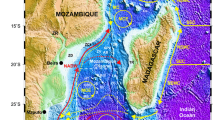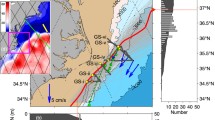Abstract
Measurements of near-seabed currents at different carbonate mound locations have demonstrated the presence and influence of bottom-magnified diurnal-period tidal motions. These bottom-trapped waves occur at a depth where the product of local vertical density stratification and seabed slope is a maximum. The seabed currents are magnified significantly if the diurnal forcing period is resonant with the combination of stratification and seabed slope. At the Belgica mounds (eastern Porcupine Sea Bight), there is a correlation between the cross-slope alignment of individual carbonate mounds and the direction of the major axis of the largest (diurnal) tides. The pattern suggests that the enhanced tidal currents play a major role in the shape of developing mounds over a long time period. A similar relation appears to hold at the Logachev mounds (SE Rockall Bank), although less clear because tides are not amplified to the same degree. At other mound locations where enhanced diurnal currents are not present, a more irregular distribution is observed. This suggests that the diurnal currents may be important only at certain carbonate mound locations, and that at these locations a more distinctive alignment of mound structures is produced.








Similar content being viewed by others
References
de Mol B, Henriet JP, Canals M (2005) Development of coral banks in Porcupine Seabight: do they have Mediterranean ancestors? In: Freiwald A, Roberts JM (eds) Cold-water corals & ecosystems. Springer, Berlin Heidelberg New York, pp 515–533
Dorschel B, Hebbeln D, Ruggeberg A, Dullo W-C, Freiwald A (2005) Growth and erosion of a cold-water coral covered carbonate mound in the Northeast Atlantic during the late Pleistocene and Holocene. Earth Planet Sci Lett 233:33–44
Egbert GD, Bennett AF, Foreman MGG (1994) Topex/Poseidon tides estimated using a global inverse model. J Geophys Res 99:24821–24852
Frederiksen R, Jensen A, Westerberg H (1992) The distribution of the scleractinian coral Lophelia pertusa around the Faeroe Islands and the relation to internal tidal mixing. Sarsia 77:157–171
Freiwald A (2002) Reef forming cold water corals. In: Wefer G, Billett D, Hebbeln D, Jørgensen BB, Schluter M, van Weering T (eds) Ocean margin systems. Springer, Berlin Heidelberg New York, pp 365–385
Huthnance JM (1974) On the diurnal tidal currents over the Rockall Bank. Deep-Sea Res 21:23–35
Huvenne V, Blondel P, Henriet JP (2002) Textural analyses of sidescan sonar imagery from two mound provinces in the Porcupine Seabight. Mar Geol 189:323–341
Kenyon NH, Akhmetzhanov AM, Wheeler AJ, van Weering TCE, de Haas H, Ivanov MI (2003) Giant carbonate mounds in the southern Rockall Trough. Mar Geol 195:5–30
Pingree RD, LeCann B (1990) Structure, strength and seasonality of the slope currents in the Bay of Biscay region. J Mar Biol Assoc UK 70:857–885
Rhines PB (1970) Edge-, bottom- and Rossby waves. Geophys Fluid Dyn 1:273–302
Roberts JM, Long D, Wilson JB, Mortensen PB, Gage JD (2003) The cold coral Lophelia pertusa (Scleractinia) and enigmatic seabed mounds along the north-east Atlantic margin; are they related? Mar Pollut Bull 46:7–20
Roberts JM, Peppe OC, Dodds LA, Mercer DJ, Thomson WT, Gage JD, Meldrum DT (2005) Monitoring environmental variability around cold-water coral reefs: the use of a benthic photolander and the potential of seafloor observatories. In: Freiwald A, Roberts JM (eds) Cold-water corals & ecosystems. Springer, Berlin Heidelberg New York, pp 483–502
Roberts JM, Wheeler AJ, Freiwald A (2006) Reefs of the deep: the biology and geology of cold-water coral ecosystems. Science 312:543–547
van Weering CE, de Haas H, de Stigter H, Lykke-Anderson H, Kouvaev I (2003) Structure and development of giant carbonate mounds at the SW and SE Rockall Trough margins, NE Atlantic Ocean. Mar Geol 198:67–81
White M (2003) Comparison of near seabed currents at two locations in the Porcupine Sea Bight—implications for benthic fauna. J Mar Biol Assoc UK 83(4):682–686
White M (2006) Benthic dynamics at the carbonate mound regions of the Porcupine Sea Bight continental margin. Int J Earth Sci DOI 10.10007/s00531-006-0099-1
White M, Mohn C, de Stigter H, Mottram G (2005) Deep water coral development as a function of hydrodynamics and surface productivity around the submarine banks of the Rockall Trough, NE Atlantic. In: Freiwald A, Roberts JM (eds) Cold-water corals & ecosystems. Springer, Berlin Heidelberg New York, pp 503–514
Acknowledgements
This work was supported through field measurements made during the European Commission funded programs Ecomound (EC contract no. EVK3-CT1999-00013) and ACES (EC contract no. EVK3-CT1999-00008), together with support from the Irish Marine Institute and through the HERMES project, EC contract no. GOCE-CT-2005-511234, funded by the EC’s Sixth Framework Programme under the priority ‘Sustainable Development, Global Change and Ecosystems.’ Bathymetry data were kindly provided by the Geological Survey of Ireland through the Irish National Seabed Survey.
Author information
Authors and Affiliations
Corresponding author
Rights and permissions
About this article
Cite this article
White, M., Roberts, J.M. & van Weering, T. Do bottom-intensified diurnal tidal currents shape the alignment of carbonate mounds in the NE Atlantic?. Geo-Mar Lett 27, 391–397 (2007). https://doi.org/10.1007/s00367-007-0060-8
Received:
Accepted:
Published:
Issue Date:
DOI: https://doi.org/10.1007/s00367-007-0060-8




